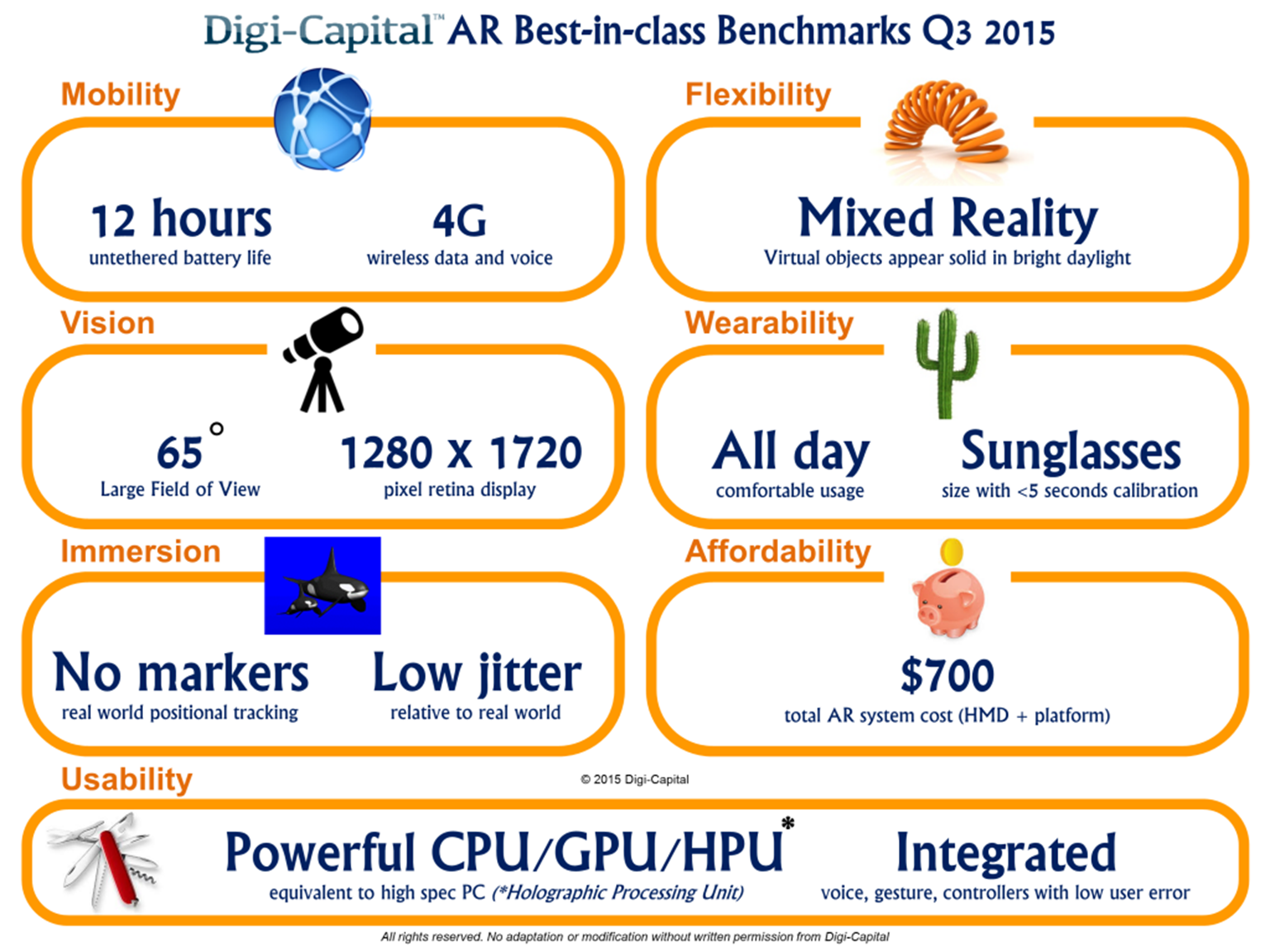Digi-Capital has completed the first technical benchmarking of augmented reality/virtual reality head-mounted displays (HMD) globally, and we would like to thank the AR/VR CEOs and CTOs who made this possible. No single company achieved best-in-class across all benchmarks, and some lesser known companies achieved some of the best scores. There are almost as many approaches as there are systems, with engineering tradeoffs depending on target market and application. In terms of market readiness, VR is ahead of AR today.
We had 26 benchmarks across seven critical success factors of mobility, vision, immersion, usability, flexibility, wearability, and affordability. The full benchmarking gets into the technical weeds, so highlights are below. Remember, these are individual best-in-class benchmarks from different companies’ products, so don’t expect them in a single magical device just yet.
VR best-in-class benchmarks
Mobility: This is only an issue for mobile VR, as console/PC VR is used at home. Heavy mobile VR use (e.g., games) drains the best-in-class smartphone battery in 6 hours — so carry a charger.
Vision: Larger fields of view and higher resolutions give better VR experiences. The best-in-class 136-degree immersive diagonal field of view and 2,560-by-1,440 pixel retina displays (no visible pixels) per eye are more than enough to keep users happy.
Immersion: Great positional tracking (where the user is looking and moving) and low jitter (virtual objects scrolling smoothly with rapid head movement) are critical for users’ feeling they are in a virtual world. The best-in-class VR systems do this perfectly at living room scale.
Usability: VR should ideally work with standard platforms (i.e., low system cost), avoid motion sickness from low frame-refresh rates, and provide intuitive user inputs. Best-in-class devices work with standard consoles/PCs/smartphones, achieve 120 frame-per-second refresh rates, and have low latency/high accuracy controllers that are user-friendly.
Flexibility: The ability to switch between VR and AR (showing virtual objects against the real world) makes VR applications more flexible. Some VR systems can already do this, but their pass-through video approach (image processed rather than seen directly) still has latency issues.
Wearability: Class-leading VR HMDs have brought weight down dramatically, increased design comfort, and can be worn for multiple hours without eye strain. While they now look like true consumer products, they still aren’t going to become fashion accessories.
Affordability: The elephant in the room is price, with the anticipated $1,500 total system (HMD + host platform) for high-end VR well understood. However you can’t get much cheaper than free mobile HMDs, and the lowest cost console/PC VR system (HMD + platform) is anticipated to be $700 to $800 because of more forgiving platform requirements.
AR best-in-class benchmarks
Mobility: AR needs to be able to make phone calls and browse outside Wi-Fi range all day before users consider trading in their smartphones. Best-in-class 12 hour untethered battery life and 4G wireless data and voice connectivity are beginning to bring that goal within reach.
Vision: Larger fields of view and higher resolutions give better AR experiences. Best-in-class 65-degree large diagonal field of view and 1,280-by-1,720 pixel retina displays per eye enable mobile computing (similar to PC/tablet) and consumer entertainment (games/films) today. They don’t achieve fully immersive Mixed Reality yet.
Immersion: Great positional tracking and low jitter are critical for AR users to feel virtual objects in the real world are actually there. Best-in-class AR systems do this without requiring physical markers for tracking, and have low jitter of virtual objects relative to the real world.
Usability: AR is a general purpose computing device, so needs to be as capable and easy to use as PC/smartphone/tablet rivals. Best-in-class systems offer a combination of CPU, GPU and HPU (Holographic Processing Unit) equivalent to a high spec PC, as well as integrated voice, gesture and controller inputs with low error rates.
Flexibility: Mixed Reality displays apparently solid virtual objects in bright daylight, enabling a broader set of applications. Best-in-class systems can do this, but their fields of view are not large enough yet to enable applications as flexible as high-end PCs.
Wearability: AR systems are trying to avoid the social issues highlighted by Google Glass. While there is still a long way to go, today’s best HMDs are lightweight, sunglasses size, and can be worn comfortably all day. They also require as little as 5 seconds’ user calibration (user fitting).
Affordability: Untethered high-end AR is still expensive, but the lowest cost tethered AR system (HMD + platform) should be $700 at launch. Not cheap, but less than some smartphones.
The AR/VR market hasn’t fully launched yet, so the technical challenges conquered are amazing. There will be bumps in the road, but it’s only a matter of time before all the best-in-class benchmarks are built into a single device. That will be AR/VR’s defining iPhone moment.
You can find out more about the full benchmarking and who’s best-in-class for each benchmark in our Augmented/Virtual Reality Report Q3 2015.
Tim Merel is founder/CEO of Eyetouch Reality and Digi-Capital.
VentureBeat's mission is to be a digital town square for technical decision-makers to gain knowledge about transformative enterprise technology and transact. Learn More



